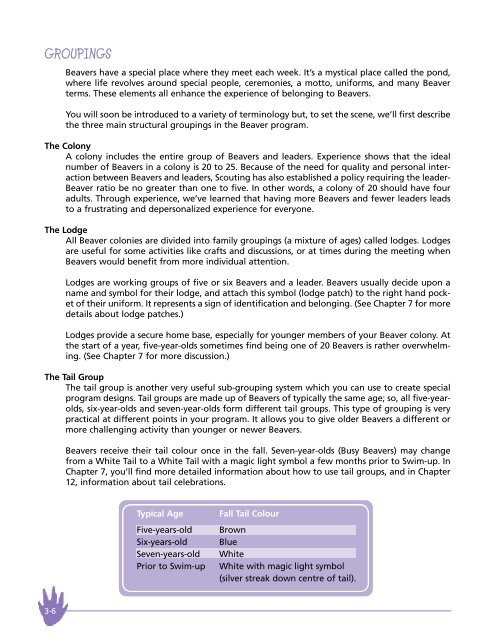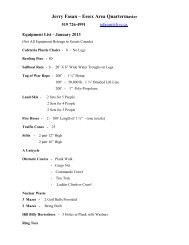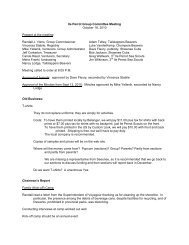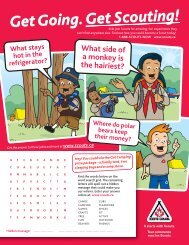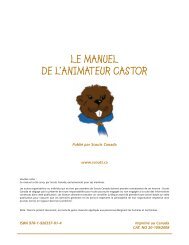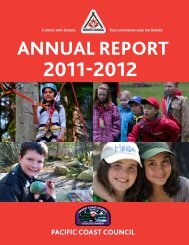Beaver Leader's Handbook - Scouts Canada
Beaver Leader's Handbook - Scouts Canada
Beaver Leader's Handbook - Scouts Canada
You also want an ePaper? Increase the reach of your titles
YUMPU automatically turns print PDFs into web optimized ePapers that Google loves.
GROUPINGS<br />
3-6<br />
<strong>Beaver</strong>s have a special place where they meet each week. It’s a mystical place called the pond,<br />
where life revolves around special people, ceremonies, a motto, uniforms, and many <strong>Beaver</strong><br />
terms. These elements all enhance the experience of belonging to <strong>Beaver</strong>s.<br />
You will soon be introduced to a variety of terminology but, to set the scene, we’ll first describe<br />
the three main structural groupings in the <strong>Beaver</strong> program.<br />
The Colony<br />
A colony includes the entire group of <strong>Beaver</strong>s and leaders. Experience shows that the ideal<br />
number of <strong>Beaver</strong>s in a colony is 20 to 25. Because of the need for quality and personal interaction<br />
between <strong>Beaver</strong>s and leaders, Scouting has also established a policy requiring the leader-<br />
<strong>Beaver</strong> ratio be no greater than one to five. In other words, a colony of 20 should have four<br />
adults. Through experience, we’ve learned that having more <strong>Beaver</strong>s and fewer leaders leads<br />
to a frustrating and depersonalized experience for everyone.<br />
The Lodge<br />
All <strong>Beaver</strong> colonies are divided into family groupings (a mixture of ages) called lodges. Lodges<br />
are useful for some activities like crafts and discussions, or at times during the meeting when<br />
<strong>Beaver</strong>s would benefit from more individual attention.<br />
Lodges are working groups of five or six <strong>Beaver</strong>s and a leader. <strong>Beaver</strong>s usually decide upon a<br />
name and symbol for their lodge, and attach this symbol (lodge patch) to the right hand pocket<br />
of their uniform. It represents a sign of identification and belonging. (See Chapter 7 for more<br />
details about lodge patches.)<br />
Lodges provide a secure home base, especially for younger members of your <strong>Beaver</strong> colony. At<br />
the start of a year, five-year-olds sometimes find being one of 20 <strong>Beaver</strong>s is rather overwhelming.<br />
(See Chapter 7 for more discussion.)<br />
The Tail Group<br />
The tail group is another very useful sub-grouping system which you can use to create special<br />
program designs. Tail groups are made up of <strong>Beaver</strong>s of typically the same age; so, all five-yearolds,<br />
six-year-olds and seven-year-olds form different tail groups. This type of grouping is very<br />
practical at different points in your program. It allows you to give older <strong>Beaver</strong>s a different or<br />
more challenging activity than younger or newer <strong>Beaver</strong>s.<br />
<strong>Beaver</strong>s receive their tail colour once in the fall. Seven-year-olds (Busy <strong>Beaver</strong>s) may change<br />
from a White Tail to a White Tail with a magic light symbol a few months prior to Swim-up. In<br />
Chapter 7, you’ll find more detailed information about how to use tail groups, and in Chapter<br />
12, information about tail celebrations.<br />
Typical Age Fall Tail Colour<br />
Five-years-old Brown<br />
Six-years-old Blue<br />
Seven-years-old White<br />
Prior to Swim-up White with magic light symbol<br />
(silver streak down centre of tail).


